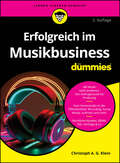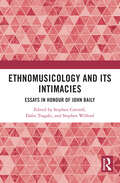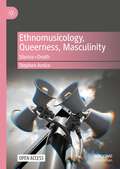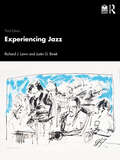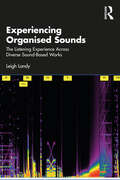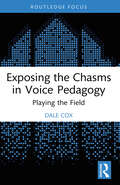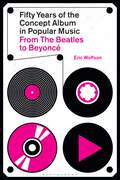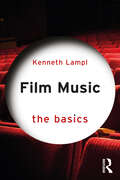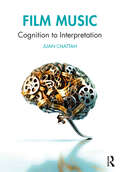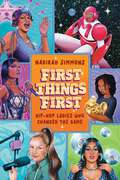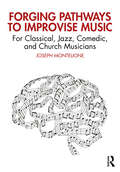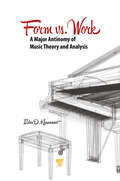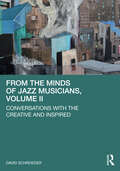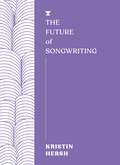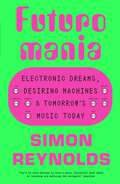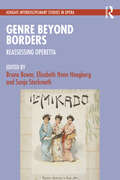- Table View
- List View
Erfolgreich im Musikbusiness für Dummies (Für Dummies)
by Christoph A. KleinSo wird das Showbusiness Ihr Business Tauchen Sie ein in die Welt der Musik und entdecken Sie, wie Sie als leidenschaftlicher Musiker oder Produzent den Sprung auf die große Bühne schaffen! Christoph Klein führt Sie durch den Dschungel von GEMA, GVL und Künstlersozialkasse, wirft einen Blick auf die juristischen Feinheiten und entwirrt den Knoten von Plattenverträgen und Co. In diesem Buch erfahren Sie alles über die wichtigsten Player der Musikindustrie, wie Sie effektives Marketing betreiben und was bei professionellen Aufnahmen und Liveauftritten zu beachten ist. Zahlreiche Checklisten, Musterverträge und hilfreiche Adressen machen es zum unverzichtbaren Begleiter auf Ihren Weg zum Erfolg. Sie erfahren Wie Sie sich auf dem Musikmarkt erfolgreich positionieren Wer im Musikbusiness alles mitwirkt Was Sie bei GEMA und Co beachten sollten Wie Sie Social Media optimal für Ihre Musik einsetzen
Ethnomusicology and its Intimacies: Essays in Honour of John Baily
by Stephen Cottrell, Dafni Tragaki, and Stephen WilfordEthnomusicology and its Intimacies situates intimacy, a concept that encompasses a wide range of often informal social practices and processes for building closeness and relationality, within the ethnomusicological study of music and sound. These scholarly essays reflect on a range of interactions between individuals and communities that deepen connections and associations, and which may be played out relatively briefly or nurtured over time. Three major sections on Performance, Auto/biographical Strategies, and Film are each prefaced by an interview with a scholar or practitioner with close knowledge of the subject that links the chapters in that section. Often drawing directly on fieldwork experience in a variety of contexts, authors consider how concepts of intimacy can illuminate the ethnographic study of music, addressing questions such as: how can we understand ethnomusicological and ethnographic research and performance as processes of musically mediated intimacy? How are the longstanding relationships we develop with others particularly intimated by and through musicking? How do we understand the musically intimate relationships of others and how do these inflect our own musical intimacies? How does music represent, inscribe, constrain, or provoke social or personal intimacies in particular contexts? The volume will appeal to all scholars with interests in music and how it is used to construct relationships in different contexts around the world.
Ethnomusicology and its Intimacies: Essays in Honour of John Baily
Ethnomusicology and its Intimacies situates intimacy, a concept that encompasses a wide range of often informal social practices and processes for building closeness and relationality, within the ethnomusicological study of music and sound. These scholarly essays reflect on a range of interactions between individuals and communities that deepen connections and associations, and which may be played out relatively briefly or nurtured over time. Three major sections on Performance, Auto/biographical Strategies, and Film are each prefaced by an interview with a scholar or practitioner with close knowledge of the subject that links the chapters in that section. Often drawing directly on fieldwork experience in a variety of contexts, authors consider how concepts of intimacy can illuminate the ethnographic study of music, addressing questions such as: how can we understand ethnomusicological and ethnographic research and performance as processes of musically mediated intimacy? How are the longstanding relationships we develop with others particularly intimated by and through musicking? How do we understand the musically intimate relationships of others and how do these inflect our own musical intimacies? How does music represent, inscribe, constrain, or provoke social or personal intimacies in particular contexts? The volume will appeal to all scholars with interests in music and how it is used to construct relationships in different contexts around the world.
Ethnomusicology, Queerness, Masculinity: Silence=Death
by Stephen AmicoThis open access book explores the disciplinary, disciplined, and recent interdisciplinary sites and productions of ethnomusicology and queerness, arguing that both academic realms are founded upon a destructive masculinity—indissolubly linked to coloniality and epistemic hegemony—and marked by a monologic, ethnocentric silencing of embodied, same-sex desire. Ethnomusicology’s fetishization of masculinizing fieldwork; queerness’s functioning as Anglophone master category; and both domains’ devaluation of sensuality and experience, concomitant with an adherence to provincial, Western conceptions of knowledge production, are revealed as precluding the possibilities for equitable, dialogic pluriversality. Enlisting the sonic as theoretical intervention, the disciplined/disciplining ethno and queer are reimagined in relation to negative emotions and intractable affect, ultimately vanquished, and replaced by explorations of sound, sex/uality, and experiential somaticity within a protean, postdisciplinary space of material/epistemic equity. This uncompromising, long-overdue critique will be of interest to researchers and students from numerous theoretical backgrounds, including music, sound, gender, queer, and postcolonial/decolonial studies.
Experiencing Jazz
by Richard J. Lawn Justin G. BinekExperiencing Jazz, Third Edition is an integrated textbook, website, and audio anthology for jazz appreciation and history courses. Through readings, illustrations, timelines, listening guides, and a playlist of tracks and performances, Experiencing Jazz journeys through the history of jazz and places the music within larger cultural and historical contexts. Designed for the jazz novice, this textbook introduces the reader to prominent artists, covers the evolution of styles, and makes stylistic comparisons to current trends and developments. New to the third edition: Richard J. Lawn is joined by new co-author Justin G. Binek Expanded coverage of artists, particularly important vocalists and prominent women in jazz, including Bobby McFerrin, Kurt Elling, The Manhattan Transfer, and Terri Lyne Carrington A dynamic, web-exclusive bonus chapter—Chapter 14.5: The Story Continues—exploring contemporary jazz artists who push the boundaries of jazz by creating new stylistic fusions and who utilize new media to create, collaborate, and share their artistry A re-worked companion website featuring new recordings, a more comprehensive audio anthology, and a major revision of The Elements of Jazz section Condensed musician biographies and updated content reflecting jazz’s global impact Revised listening guides for spotlighted recordings highlighting key moments worthy of closer listening and analysis Comprehensive and immersive, the third edition of Experiencing Jazz provides a foundational understanding of the history of the genre.
Experiencing Jazz
by Richard J. Lawn Justin G. BinekExperiencing Jazz, Third Edition is an integrated textbook, website, and audio anthology for jazz appreciation and history courses. Through readings, illustrations, timelines, listening guides, and a playlist of tracks and performances, Experiencing Jazz journeys through the history of jazz and places the music within larger cultural and historical contexts. Designed for the jazz novice, this textbook introduces the reader to prominent artists, covers the evolution of styles, and makes stylistic comparisons to current trends and developments. New to the third edition: Richard J. Lawn is joined by new co-author Justin G. Binek Expanded coverage of artists, particularly important vocalists and prominent women in jazz, including Bobby McFerrin, Kurt Elling, The Manhattan Transfer, and Terri Lyne Carrington A dynamic, web-exclusive bonus chapter—Chapter 14.5: The Story Continues—exploring contemporary jazz artists who push the boundaries of jazz by creating new stylistic fusions and who utilize new media to create, collaborate, and share their artistry A re-worked companion website featuring new recordings, a more comprehensive audio anthology, and a major revision of The Elements of Jazz section Condensed musician biographies and updated content reflecting jazz’s global impact Revised listening guides for spotlighted recordings highlighting key moments worthy of closer listening and analysis Comprehensive and immersive, the third edition of Experiencing Jazz provides a foundational understanding of the history of the genre.
Experiencing Organised Sounds: The Listening Experience Across Diverse Sound-Based Works
by Leigh LandyExperiencing Organised Sounds investigates a wide horizon of sound-based works using a template consistently across its 16 studies. It has been written for both specialist and non-specialist readers aiming to address means of increasing appreciation and understanding related to the experience of sonic creativity (music involving any sounds, not just musical notes) across this repertoire, as well as to launch a discussion about how the reception of sonic creativity can be influenced by the circumstances of listening – in particular, regarding the qualitative difference between the in-situ as opposed to mediated experience. Although listening is the volume’s focus, complementary information from the musicians is offered to facilitate holistic work overviews. As the first composition presented was composed by a 15-year-old, the intention is to demonstrate that what might be considered a niche area of the contemporary arts is one in which both increased appreciation and participation could and should easily be achieved. The book’s work discussions are divided over three central chapters focused on fixed-medium compositions, performed and sound artworks. Experiencing Organised Sounds can be used as an undergraduate textbook, by experienced readers or those new to the area. All works discussed and related materials are available to readers online.
Experiencing Organised Sounds: The Listening Experience Across Diverse Sound-Based Works
by Leigh LandyExperiencing Organised Sounds investigates a wide horizon of sound-based works using a template consistently across its 16 studies. It has been written for both specialist and non-specialist readers aiming to address means of increasing appreciation and understanding related to the experience of sonic creativity (music involving any sounds, not just musical notes) across this repertoire, as well as to launch a discussion about how the reception of sonic creativity can be influenced by the circumstances of listening – in particular, regarding the qualitative difference between the in-situ as opposed to mediated experience. Although listening is the volume’s focus, complementary information from the musicians is offered to facilitate holistic work overviews. As the first composition presented was composed by a 15-year-old, the intention is to demonstrate that what might be considered a niche area of the contemporary arts is one in which both increased appreciation and participation could and should easily be achieved. The book’s work discussions are divided over three central chapters focused on fixed-medium compositions, performed and sound artworks. Experiencing Organised Sounds can be used as an undergraduate textbook, by experienced readers or those new to the area. All works discussed and related materials are available to readers online.
Exposing the Chasms in Voice Pedagogy: Playing the Field
by Dale CoxThis concise book critically examines the intersection of power, privilege, and classical music in higher education through an extensive study of the experiences, training, and background of teachers of musical theatre singing.Mapping the divides within the voice pedagogy field, it shows how despite the growth of non-classical programmes, the teaching of vocal music in the United States continues to be structurally dominated by Western classical music. Drawing on extensive fieldwork and observations of practicing instructors, the author argues that current voice pedagogy training’s classical-centred approach fails to prepare instructors to teach the range of vocal styles needed in the contemporary musical theatre profession. Combining a critical review of existing practices with proposals for change, this book sheds light on a key problem in voice pedagogy today.Based on field research and drawing on both Shulman’s signature pedagogies theory and Bourdieu’s concepts of habitus, capitals, practice, and field, this book will be useful for scholars, researchers, and practitioners of voice pedagogy, higher music education, performance education, cultural studies, music, musical theatre, and theatre studies.
Exposing the Chasms in Voice Pedagogy: Playing the Field
by Dale CoxThis concise book critically examines the intersection of power, privilege, and classical music in higher education through an extensive study of the experiences, training, and background of teachers of musical theatre singing.Mapping the divides within the voice pedagogy field, it shows how despite the growth of non-classical programmes, the teaching of vocal music in the United States continues to be structurally dominated by Western classical music. Drawing on extensive fieldwork and observations of practicing instructors, the author argues that current voice pedagogy training’s classical-centred approach fails to prepare instructors to teach the range of vocal styles needed in the contemporary musical theatre profession. Combining a critical review of existing practices with proposals for change, this book sheds light on a key problem in voice pedagogy today.Based on field research and drawing on both Shulman’s signature pedagogies theory and Bourdieu’s concepts of habitus, capitals, practice, and field, this book will be useful for scholars, researchers, and practitioners of voice pedagogy, higher music education, performance education, cultural studies, music, musical theatre, and theatre studies.
Fifty Years of the Concept Album in Popular Music: From The Beatles to Beyoncé
by Eric WolfsonThe concept album is one of popular music's most celebrated-and misunderstood-achievements. This book examines the untold history of the rock concept album, from The Beatles to Beyoncé.The roots of the concept album are nearly as old as the long-playing record itself, as recording artists began using the format to transcend a mere collection of songs into a listening experience that takes the listener on a journey through its unifying mood, theme, narrative, or underlying idea.Along the way, artists as varied as the Moody Blues, Jimi Hendrix, Joni Mitchell, Pink Floyd, Parliament, Donna Summer, Iron Maiden, Radiohead, The Notorious B.I.G., Green Day, Janelle Monáe, and Kendrick Lamar created albums that form an extended conversation of art and music. Limits were pushed as the format grew over the subsequent eras. Seminal albums like the Beatles' Sgt. Pepper's Lonely Hearts Club Band, the Who's Tommy, Marvin Gaye's What's Going On, stand alongside modern classics like Liz Phair's Exile in Guyville, Kendrick Lamar's good kid, "m.A.A.d city," and Beyoncé's Lemonade. Mixing iconic albums with some newer and lesser-known works makes for a book that ventures into the many sides of a history that has yet to be told-until now.
Film Music: The Basics (The Basics)
by Kenneth LamplA comprehensive introduction to film music, this book provides a concise and illuminating summary of the process of film scoring, as well as a succinct overview of the rich history of contemporary film music. Written in a non-technical style, this book begins by presenting a brief history of film music from the last 30 years, covering topics ranging from blockbuster franchises to indie film scores. It explores film music from around the world, including Bollywood and European Avant-garde cinema, and film music in animation, like Disney-Pixar and Japanese anime. It then offers a guide to the language of film music analysis, the creative process behind composing film music, and the use of current technology. The book champions diversity in the industry, with case studies and interviews from a range of active film composers, including: Pinar Toprak (Captain Marvel, 2019), Kris Bowers (Bridgerton, 2020), Natalie Holt (Loki, 2021), and Rachel Portman (Emma, 1996), Complete with a glossary of key terms and further reading, this book is an invaluable resource for all those beginning to study film music, as well as lifelong film music buffs seeking to update their understanding of film music.
Film Music: The Basics (The Basics)
by Kenneth LamplA comprehensive introduction to film music, this book provides a concise and illuminating summary of the process of film scoring, as well as a succinct overview of the rich history of contemporary film music. Written in a non-technical style, this book begins by presenting a brief history of film music from the last 30 years, covering topics ranging from blockbuster franchises to indie film scores. It explores film music from around the world, including Bollywood and European Avant-garde cinema, and film music in animation, like Disney-Pixar and Japanese anime. It then offers a guide to the language of film music analysis, the creative process behind composing film music, and the use of current technology. The book champions diversity in the industry, with case studies and interviews from a range of active film composers, including: Pinar Toprak (Captain Marvel, 2019), Kris Bowers (Bridgerton, 2020), Natalie Holt (Loki, 2021), and Rachel Portman (Emma, 1996), Complete with a glossary of key terms and further reading, this book is an invaluable resource for all those beginning to study film music, as well as lifelong film music buffs seeking to update their understanding of film music.
Film Music: Cognition to Interpretation
by Juan ChattahFilm Music: Cognition to Interpretation explores the dynamic counterpoint between a film’s soundtrack, its visuals and narrative, and the audience’s perception and construction of meaning. Adopting a holistic approach covering both the humanities and the sciences—blending cognitive psychology, musical analysis, behavioral neuroscience, semiotics, linguistics, and other related fields—the author examines the perceptual and cognitive processes that elicit musical meaning in film and breathe life into our cinematic experiences. A clear and engaging writing style distills complex concepts, theories, and analytical methodologies into explanations accessible to readers from diverse disciplinary backgrounds, making it an indispensable companion for scholars and students of music, film studies, and cognition. Across ten chapters, extensive appendices, and hundreds of film references, Film Music: Cognition to Interpretation offers a new mode of analysis, inviting readers to unlock a deeper understanding of the expressive power of film music.
Film Music: Cognition to Interpretation
by Juan ChattahFilm Music: Cognition to Interpretation explores the dynamic counterpoint between a film’s soundtrack, its visuals and narrative, and the audience’s perception and construction of meaning. Adopting a holistic approach covering both the humanities and the sciences—blending cognitive psychology, musical analysis, behavioral neuroscience, semiotics, linguistics, and other related fields—the author examines the perceptual and cognitive processes that elicit musical meaning in film and breathe life into our cinematic experiences. A clear and engaging writing style distills complex concepts, theories, and analytical methodologies into explanations accessible to readers from diverse disciplinary backgrounds, making it an indispensable companion for scholars and students of music, film studies, and cognition. Across ten chapters, extensive appendices, and hundreds of film references, Film Music: Cognition to Interpretation offers a new mode of analysis, inviting readers to unlock a deeper understanding of the expressive power of film music.
First Things First: Hip-Hop Ladies Who Changed the Game
by Nadirah SimmonsThis enlightening book reframes the history of hip-hop—and this time, women are given credit for all their trailblazing achievements that have left an undeniable impact on music. FIRST THINGS FIRST, hip-hop is not just the music, and women have played a big role in shaping the way it looks today. FIRST THINGS FIRST takes readers on a journey through some notable firsts by women in hip-hop history and their importance. Factual firsts like Queen Latifah becoming the first rapper to get a star on the Hollywood Walk of Fame, Lauryn Hill making history as the first rapper to win the coveted Album of the Year Award at the GRAMMYs, April Walker being the first woman to dominate in the hip-hop fashion game, and Da Brat being the first solo woman rapper to have an album go platinum, and metaphorical firsts like Missy Elliott being the first woman rapper to go to the future. (Trust me, she really did.) There are chapters on music legends like Nicki Minaj, Lil&’ Kim and Mary J. Blige, tv and radio hosts like Big Lez and Angie Martinez, and so many more ladies I would name but I don&’t want to spoil the book! There are games, charts and some fire images, too. Altogether, FIRST THINGS FIRST is a celebration of the achievements of women in hip-hop who broke down barriers and broke the mold. So the next time someone doesn&’t have their facts straight on the ladies in hip-hop, you can hit them with &“first things first&”…
Forging Pathways to Improvise Music: For Classical, Jazz, Comedic, and Church Musicians
by Joseph MontelioneA step-by-step resource on forging one’s own pathway to improvise music, this book guides the musician through a clear and simple method that will easily translate to the reader’s genre of choice. Many musicians struggle with improvisation. Coincidentally, educators also find it challenging to integrate improvisation into curriculum. This book breaks down the barriers most performers and educators combat in the learning and teaching of improvisation, and is a helpful approach to demystify the complicated sphere of music improvisation. Divided into three sections, the first part of the book helps the reader develop an improvisatorial mindset to mentally conceive musical ideas, regardless of genre. The second portion then connects the improviser’s mindset to translating those ideas into a compelling musical performance in real time. The book’s final third assists the reader with discovering how to apply this method of improvisation to the nuanced liturgical, comedic, jazz, and classical styles. Forging Pathways to Improvise Music offers a practical introduction to improvisational methods essential for educators, students, and musicians of diverse educational backgrounds and musical genres.
Forging Pathways to Improvise Music: For Classical, Jazz, Comedic, and Church Musicians
by Joseph MontelioneA step-by-step resource on forging one’s own pathway to improvise music, this book guides the musician through a clear and simple method that will easily translate to the reader’s genre of choice. Many musicians struggle with improvisation. Coincidentally, educators also find it challenging to integrate improvisation into curriculum. This book breaks down the barriers most performers and educators combat in the learning and teaching of improvisation, and is a helpful approach to demystify the complicated sphere of music improvisation. Divided into three sections, the first part of the book helps the reader develop an improvisatorial mindset to mentally conceive musical ideas, regardless of genre. The second portion then connects the improviser’s mindset to translating those ideas into a compelling musical performance in real time. The book’s final third assists the reader with discovering how to apply this method of improvisation to the nuanced liturgical, comedic, jazz, and classical styles. Forging Pathways to Improvise Music offers a practical introduction to improvisational methods essential for educators, students, and musicians of diverse educational backgrounds and musical genres.
Form vs. Work: A Major Antinomy of Music Theory and Analysis
by Ildar D. KhannanovThe antinomy of musical work and musical form has been central for music theory for centuries. Musical work is complete and all-inclusive, which makes it an ideal object of study. However, the teaching of musical form, albeit selective, is self-sufficient and epistemologically sovereign. The book offers both the historical overview and the analytical discourse on this antinomy in both Western and Russian perspectives. It presents an insider’s view of the latter and contains materials never previously published.
Form vs. Work: A Major Antinomy of Music Theory and Analysis
by Ildar D. KhannanovThe antinomy of musical work and musical form has been central for music theory for centuries. Musical work is complete and all-inclusive, which makes it an ideal object of study. However, the teaching of musical form, albeit selective, is self-sufficient and epistemologically sovereign. The book offers both the historical overview and the analytical discourse on this antinomy in both Western and Russian perspectives. It presents an insider’s view of the latter and contains materials never previously published.
From the Minds of Jazz Musicians, Volume II: Conversations with the Creative and Inspired
by David SchroederFrom the Minds of Jazz Musicians, Volume II is a follow-up to Volume I’s celebration of contemporary jazz artists who have toiled, struggled and succeeded in finding their creative space. Volume II was developed through transcribing and editing selected interviews with 29 jazz artists, conducted by the author since 2011, along with a historical essay on each artist. The interviews feature musicians from a broad range of musical styles and experiences, with their beginnings ranging from the 50s to the early 80s. Topics range from biographical life histories to descriptions of mentor relationships, revealing the important life lessons they learned along the way. With the goal to discover the person behind the persona, the author elicits conversations that speak of the creative process, mining the individualistic perspectives of seminal artists who witnessed history in the making. By comparing and contrasting each artist’s perspective to discover similarities in their career paths. these volumes are an important research tool for students and academics, offering direct information from leading figures in the jazz world.
From the Minds of Jazz Musicians, Volume II: Conversations with the Creative and Inspired
by David SchroederFrom the Minds of Jazz Musicians, Volume II is a follow-up to Volume I’s celebration of contemporary jazz artists who have toiled, struggled and succeeded in finding their creative space. Volume II was developed through transcribing and editing selected interviews with 29 jazz artists, conducted by the author since 2011, along with a historical essay on each artist. The interviews feature musicians from a broad range of musical styles and experiences, with their beginnings ranging from the 50s to the early 80s. Topics range from biographical life histories to descriptions of mentor relationships, revealing the important life lessons they learned along the way. With the goal to discover the person behind the persona, the author elicits conversations that speak of the creative process, mining the individualistic perspectives of seminal artists who witnessed history in the making. By comparing and contrasting each artist’s perspective to discover similarities in their career paths. these volumes are an important research tool for students and academics, offering direct information from leading figures in the jazz world.
Futuromania: Electronic Dreams, Desiring Machines and Tomorrow’s Music Today
by Simon ReynoldsSimon Reynolds's first book in eight years is a celebration of music that feels like a taste of tomorrow. Sounds that prefigure pop music's future - the vanguard genres and heroic innovators whose discoveries eventually get accepted by the wider mass audience. But it's also about the way music can stir anticipation for a thrillingly transformed world just around the corner: a future that might be utopian or dystopian, but at least will be radically changed and exhilaratingly other. Starting with an extraordinary chapter on Giorgio Moroder and Donna Summer, taking in illuminating profiles of Ryuichi Sakamoto, Boards of Canada, Burial, and Daft Punk, and arguing for Auto-Tune as the defining sound of 21st century pop, Futuromania shapes over two-dozen essays and interviews into a chronological narrative of machine-music from the 1970s to now. Reynolds explores the interface between pop music and science fiction's utopian dreams and nightmare visions, always emphasising the quirky human individuals abusing the technology as much as the era-defining advances in electronic hardware and digital software. A tapestry of the scenes and subcultures that have proliferated in that febrile, sexy and contested space where man meets machine, Futuromania is an enthused listening guide that will propel readers towards adventures in sound. There is a lifetime of electronic listening here.
Genre Beyond Borders: Reassessing Operetta (Ashgate Interdisciplinary Studies in Opera)
This book offers an innovative approach to understanding operetta, drawing attention to its malleability and resistance to boundaries. These shows have traversed (and continue to traverse) with ease the national borders which might superficially define them, or draw on features from many other genres without fundamentally changing in tone or approach. The chapters move from nineteenth-century London and Paris to twentieth-century North America, South America and Europe to present-day Australia. Some offer fresh understandings of familiar composers, such as Johann Strauss or Gilbert and Sullivan, while others examine works or composers that are less well-known. The chapter on Socialist operetta in Czechoslovakia in particular will almost certainly be a revelation to anyone from Western Europe or the US, where operetta is often understood to be a bourgeois phenomenon. As a summary of the current state of the field, this collection showcases the many possible pathways for future scholars who wish to explore it.
